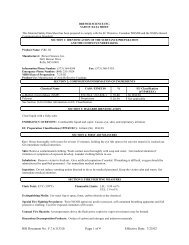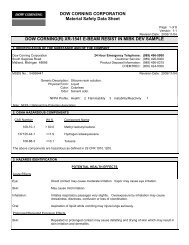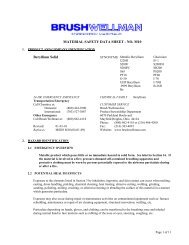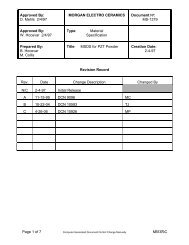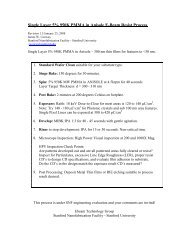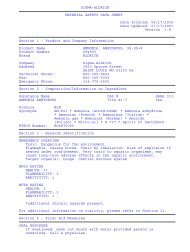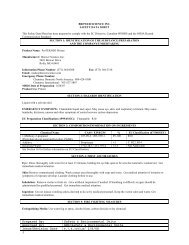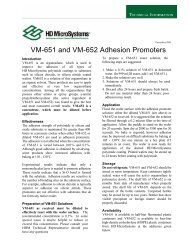Material Safety Data Sheet Tetrakis(dimethylamino)tin Section 1 ...
Material Safety Data Sheet Tetrakis(dimethylamino)tin Section 1 ...
Material Safety Data Sheet Tetrakis(dimethylamino)tin Section 1 ...
You also want an ePaper? Increase the reach of your titles
YUMPU automatically turns print PDFs into web optimized ePapers that Google loves.
<strong>Material</strong> <strong>Safety</strong> <strong>Data</strong> <strong>Sheet</strong><br />
<strong>Tetrakis</strong>(<strong>dimethylamino</strong>)<strong>tin</strong><br />
<strong>Section</strong> 1 - Chemical Product and Company Identification<br />
MSDS Name: <strong>Tetrakis</strong>(<strong>dimethylamino</strong>)<strong>tin</strong><br />
Catalog Numbers: 32106-0000, 32106-0010<br />
Synonyms:<br />
Company Identification:<br />
Acros Organics BVBA<br />
Janssen Pharmaceuticalaan 3a<br />
2440 Geel, Belgium<br />
Acros Organics<br />
Company Identification: (USA)<br />
One Reagent Lane<br />
Fair Lawn, NJ 07410<br />
For information in the US, call: 800-ACROS-01<br />
For information in Europe, call: +32 14 57 52 11<br />
Emergency Number, Europe: +32 14 57 52 99<br />
Emergency Number US: 201-796-7100<br />
CHEMTREC Phone Number, US: 800-424-9300<br />
CHEMTREC Phone Number, Europe: 703-527-3887<br />
Hazard Symbols: T F<br />
<strong>Section</strong> 2 - Composition, Information on Ingredients<br />
CAS# Chemical Name: % EINECS#<br />
1066-77-9 <strong>Tetrakis</strong>(<strong>dimethylamino</strong>)<strong>tin</strong> 96% unlisted<br />
<br />
Risk Phrases: 11 23/24/25 36/37/38 41<br />
<strong>Section</strong> 3 - Hazards Identification<br />
EMERGENCY OVERVIEW<br />
Highly flammable. Toxic by inhalation, in contact with skin and if swallowed. Irrita<strong>tin</strong>g to eyes, respiratory system and skin.<br />
Risk of serious damage to eyes.<br />
Potential Health Effects<br />
Eye: Causes eye irritation. Risk of serious damage to eyes.<br />
Skin: Causes skin irritation. May cause dermatitis. Toxic in contact with skin.<br />
Ingestion: May cause irritation of the digestive tract. Toxic if swallowed.<br />
Inhalation: Causes respiratory tract irritation. Toxic if inhaled.<br />
Chronic: Prolonged or repeated exposure may cause nausea, dizziness, and headache.<br />
<strong>Section</strong> 4 - First Aid Measures<br />
Eyes:<br />
Immediately flush eyes with plenty of water for at least 15 minutes, occasionally lif<strong>tin</strong>g the upper and lower<br />
eyelids. Get medical aid immediately.<br />
Skin:<br />
Get medical aid immediately. Immediately flush skin with plenty of water for at least 15 minutes while<br />
removing contaminated clothing and shoes.<br />
Ingestion: Get medical aid immediately. Wash mouth out with water.<br />
Inhalation:<br />
Get medical aid immediately. Remove from exposure and move to fresh air immediately. If not breathing,<br />
give artificial respiration. If breathing is difficult, give oxygen.
Notes to<br />
Physician:<br />
General<br />
Information:<br />
Ex<strong>tin</strong>guishing<br />
Media:<br />
General<br />
Information:<br />
Spills/Leaks:<br />
Handling:<br />
Storage:<br />
<strong>Section</strong> 5 - Fire Figh<strong>tin</strong>g Measures<br />
As in any fire, wear a self-contained breathing apparatus in pressure-demand, MSHA/NIOSH (approved<br />
or equivalent), and full protective gear. Vapors can travel to a source of ignition and flash back. Will burn if<br />
involved in a fire. Flammable liquid and vapor.<br />
Use foam, dry chemical, or carbon dioxide. DO NOT USE WATER!<br />
<strong>Section</strong> 6 - Accidental Release Measures<br />
Use proper personal protective equipment as indicated in <strong>Section</strong> 8.<br />
Absorb spill with inert material (e.g. vermiculite, sand or earth), then place in suitable container. Remove<br />
all sources of ignition. Use a spark-proof tool.<br />
<strong>Section</strong> 7 - Handling and Storage<br />
Use spark-proof tools and explosion proof equipment. Do not breathe dust, vapor, mist, or gas. Do not get in<br />
eyes, on skin, or on clothing. Use only in a chemical fume hood.<br />
Keep away from sources of ignition. Store in a cool, dry place. Store in a tightly closed container. Flammablesarea.<br />
Engineering Controls:<br />
Exposure Limits<br />
<strong>Section</strong> 8 - Exposure Controls, Personal Protection<br />
Use adequate ventilation to keep airborne concentrations low.<br />
CAS# 1066-77-9:<br />
Personal Protective Equipment<br />
Eyes: Wear chemical splash goggles.<br />
Skin: Wear appropriate protective gloves to prevent skin exposure.<br />
Clothing: Wear appropriate protective clothing to prevent skin exposure.<br />
Follow the OSHA respirator regulations found in 29 CFR 1910.134 or European Standard EN 149. Use a<br />
Respirators: NIOSH/MSHA or European Standard EN 149 approved respirator if exposure limits are exceeded or if<br />
irritation or other symptoms are experienced.<br />
<strong>Section</strong> 9 - Physical and Chemical Properties<br />
Physical State: Clear liquid<br />
Color: Clear<br />
Odor: Not available<br />
pH: Not available<br />
Vapor Pressure: Not available<br />
Viscosity: Not available<br />
Boiling Point: 53 - 55 deg C @0.1mmHg<br />
Freezing/Mel<strong>tin</strong>g Point: Not available<br />
Autoignition Temperature: Not available<br />
Flash Point: -7 deg C ( 19.40 deg F)<br />
Explosion Limits: Lower: Not available<br />
Explosion Limits: Upper: Not available<br />
Decomposition Temperature: Not available<br />
Solubility in water: Not available<br />
Specific Gravity/Density: 1.170<br />
Molecular Formula: C8H24N4Sn<br />
Molecular Weight: 295.02
Not available<br />
<strong>Section</strong> 10 - Stability and Reactivity<br />
Chemical Stability: Moisture sensitive.<br />
Conditions to Avoid: Incompatible materials, ignition sources, exposure to moist air or water.<br />
Incompatibilities with Other <strong>Material</strong>s Water, strong oxidizing agents.<br />
Hazardous Decomposition Products Nitrogen oxides, carbon monoxide, carbon dioxide, <strong>tin</strong>/<strong>tin</strong> oxides.<br />
Hazardous Polymerization Has not been reported.<br />
<strong>Section</strong> 11 - Toxicological Information<br />
RTECS#: CAS# 1066-77-9: None listed<br />
LD50/LC50: RTECS: Not available.<br />
Carcinogenicity: <strong>Tetrakis</strong>(<strong>dimethylamino</strong>)<strong>tin</strong> - Not listed as a carcinogen by ACGIH, IARC, NTP, or CA Prop 65.<br />
Other: The toxicological properties have not been fully investigated.<br />
<strong>Section</strong> 12 - Ecological Information<br />
<strong>Section</strong> 13 - Disposal Considerations<br />
Dispose of in a manner consistent with federal, state, and local regulations.<br />
<strong>Section</strong> 14 - Transport Information<br />
IATA IMO RID/ADR<br />
Shipping FLAMMABLE LIQUID, FLAMMABLE LIQUID, FLAMMABLE LIQUID,<br />
Name: TOXIC, N.O.S.*<br />
TOXIC, N.O.S.<br />
TOXIC, N.O.S.<br />
Hazard<br />
Class:<br />
3 (6.1) 3 (6.1) 3 (6.1)<br />
UN Number: 1992 1992 1992<br />
Packing<br />
Group:<br />
II II II<br />
Severe Marine Pollutant<br />
European/International Regulations<br />
European Labeling in Accordance with EC Directives<br />
Hazard Symbols: T F<br />
Risk Phrases:<br />
<strong>Section</strong> 15 - Regulatory Information<br />
R 11 Highly flammable.<br />
R 23/24/25 Toxic by inhalation, in contact with skin and if swallowed.<br />
R 36/37/38 Irrita<strong>tin</strong>g to eyes, respiratory system and skin.<br />
R 41 Risk of serious damage to eyes.<br />
<strong>Safety</strong> Phrases:<br />
S 16 Keep away from sources of ignition - No smoking.<br />
S 26 In case of contact with eyes, rinse immediately with plenty of water and seek medical advice.<br />
S 36/37/39 Wear suitable protective clothing, gloves and eye/face protection.<br />
WGK (Water Danger/Protection)<br />
Canada<br />
US Federal<br />
TSCA<br />
CAS# 1066-77-9: Not available<br />
CAS# 1066-77-9 is not listed on the TSCA Inventory. It is for research and development use only.<br />
<strong>Section</strong> 16 - Other Information<br />
MSDS Creation Date: 2/17/1997<br />
Revision #1 Date 4/28/2004
Revisions were made in <strong>Section</strong>s: General revision.<br />
The information above is believed to be accurate and represents the best information currently available<br />
to us. However, we make no warranty of merchantibility or any other warranty, express or implied,<br />
with respect to such information, and we assume no liability resul<strong>tin</strong>g from its use. Users should make<br />
their own investigations to determine the suitability of the information for their particular purposes. In no<br />
event shall the company be liable for any claims, losses, or damages of any third party or for lost profits<br />
or any special, indirect, incidental, consequential, or exemplary damages howsoever arising, even if the<br />
company has been advised of the possibility of such damages.<br />
--------------------------------------------------------------------------------



